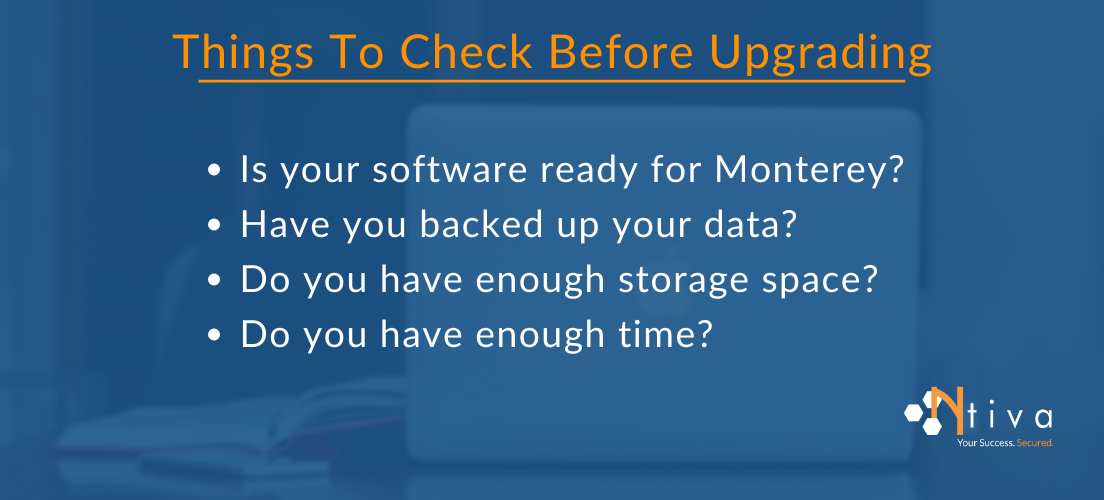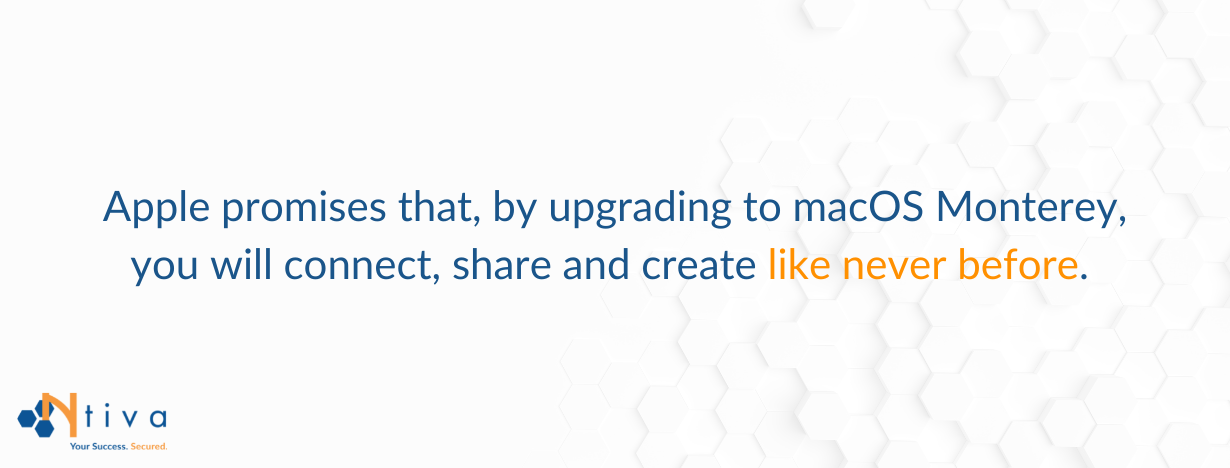At the time, we recommended that our customers not upgrade their operating systems on the release date unless they had a spare computer lying around. And Apple proved us right in our caution by launching a major update of Monterey on January 26, 2022.
Here’s what your upgrade process to macOS 12 Monterey should look like now.
Don't want to read the article? Watch the full recording below.
Be sure to register here for the Apple for Business webinar series!
Why We Block macOS Upgrades
At Ntiva, we’re not control freaks. Not all the time, anyway. We don't want to stop you from doing something that you want to do.
But what we have learned over the years is that many organizations upgrade by accident. They either think they are applying a simple update, or they're not as prepared as they thought for the upgrade. Some organizations think, "Well, this is only going to affect me and my system," even when upgrading macOS can actually affect an entire team and an entire team's workflow.
What we've learned the hard way is that no organization should upgrade macOS until they are fully prepared.
That’s why we block macOS upgrades. We’d much rather have a conversation with someone about why we're blocking an upgrade and how to properly implement it, than discuss why their Macs are down for an entire day, maybe even longer, because of the fallout caused by an unplanned upgrade.
Apple macOS Updates Versus Upgrades
The difference between an update and an upgrade is primarily in the number of modifications and in the importance of those modifications.
- An OS update doesn’t change an operating system’s core structure or look and feel, while an OS upgrade often does
- Updates are frequent (think weeks), while upgrades are infrequent (think months or years)
- Updates typically take mere minutes, while upgrades require hours
- Updates tend to be small relative to the size of the OS (a dozen kilobytes or a few megabytes), while upgrades are massive, typically hundreds or even thousands of megabytes
- Updates add a few digits after the decimal point in OS version number (from 11.0 to 11.01, for instance), while upgrades change the number before the decimal in the OS (from 11.01 to 12, for example), and sometimes involve a new name (Monterey replaces Big Sur, which replaced Catalina, which replaced Mojave).
Things to Check Before Upgrading to macOS 12 Monterey
Before you upgrade to the latest macOS, ensure that you are prepared for the move by answering these four questions:

1. Is your software up to date and ready for Monterey?
Upgrades are the ones that typically break workflows and software that's not up to date, especially outdated software that’s not compatible with the upgrade. Occasionally people are sitting on older operating systems, or older machines, that cannot upgrade to the new OS.
2. Have you backed up your data?
Be prepared for problems. During the upgrade process, things can go south, whether that’s a hard drive failure or just an operating system that doesn't operate as planned. You may end up in a place where you have to start over, maybe even erasing the machine to get it back into a proper state. So to be safe, run a comprehensive backup of any machine before upgrading to macOS 12 Monterey.
3. Do you have enough storage space?
To install macOS 12 Monterey, you need enough storage space on your device to both download the new OS and to provide space for the upgrade to take place. Before you upgrade, check to see how much space you need. Last time we checked, you needed at least 49Gb of free space.
4. Do you have enough time to upgrade?
Upgrades are an iterative process that can take up to two hours and involve multiple reboots of a device. Some of these reboots require the user to enter their username and password. You must ensure you have two hours to spare to sit by each machine you are upgrading, so you can follow each prompt to restart and keep the upgrade process moving along.
How to Upgrade to macOS 12 Monterey

Upgrading to the new version of macOS isn’t just a matter of downloading and installing the latest version of the Mac operating system. Follow these steps to ensure you have a successful upgrade.
- Check compatibility. macOS Monterey is compatible with newer Apple computers only. View the complete list of compatible computers.
- Make a backup. Backup your Mac using Time Machine or another backup method.
- Download macOS Monterey. Choose Apple menu > System Preferences, then click Software Update.
- Install macOS Monterey. After downloading, the installer opens automatically. Click Continue and follow the onscreen instructions and prompts.
- Stay up to date. After you upgrade to macOS Monterey, Apple will notify you when updates to macOS Monterey are available. To check for these updates yourself, choose Apple menu > System Preferences, then choose Software Update.
A Smooth and Seamless Upgrade to macOS Monterey
Apple promises that, by upgrading to macOS Monterey, you will connect, share and create like never before. This latest version of the macOS offers FaceTime updates, a redesigned and streamlined Safari browser, and powerful new ways to work using Shortcuts.
Just make sure you are ready for the upgrade. Follow the steps we’ve just outlined, and you should be good to go.
If you need help upgrading to macOS Monterey on multiple machines in an enterprise environment, investigate Apple Services, Security and Support from Ntiva. You have invested in Apple technology for your workforce, so you deserve the best when it comes to service and support.
.png?width=580&name=Monterey%20Blog(1).png)


.jpeg?width=300&name=Blog%2025%20Refresh%20(1).jpeg)
